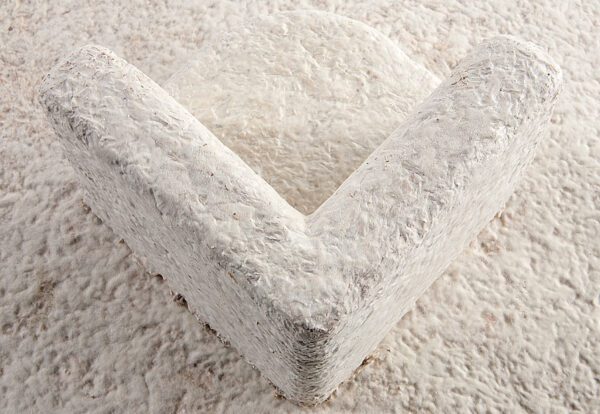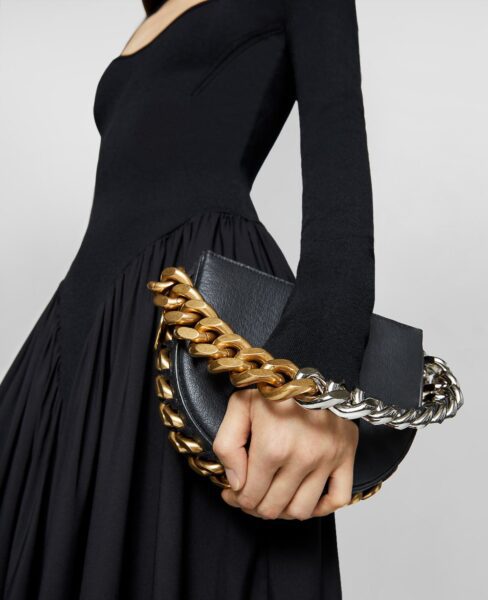Mushrooms x Hemp: The collab we’ve all been waiting for.
Why we’re getting “high” on the eco-friendly possibilities of biomaterial
5 reasons why mushroom and hemp are not there to get you high
Newsflash, there is more to the humble mushroom than you might think. While we’re totally down with the idea of mushroom tagliatelle, truffles, and the medicinal promises of magic mushroom tea, your average shroom has more to offer. And no – we don’t mean to get totally high; mushrooms can be turned into a whole host of interesting and useful by-products for us to use in our everyday.
In the context of the environmental crisis, the benefits stand out like a sore thumb. They are as adaptable as any biomaterial – with their durability and lightweight nature – whilst also being readily available. All this means is that mushrooms can – and are – being used in almost everything from bricks and paneling in houses to packaging and fashion.
What is it about mushrooms that make them so special? And how does this fit into the future? Here we explore the ways mushrooms are becoming BFFs with hemp to create the biggest, baddest biomaterial collab that the world needs.
Why we need bio-based alternatives
It’s a fact: if we keep going as we have been, the planet is not going to look great in a couple of decades. Pollutants and plastic waste are two of the major factors in climate change with organizations and businesses around the globe trying to find ways to reduce their environmental impact.
When we talk about the plastic waste problem, stats show that global plastic waste has more than doubled between 2000 and 2019, with 40% of this coming from packaging. You only need to see images of ocean plastic to draw a collective shudder at the scale of it, but let’s also not forget microplastics. Those teeny, little pieces of plastic that swish around in our oceans, go into our soil, are consumed by fish and animals, and eventually wind up in our very own bodies. Yep, that’s what we’re talking about.
It’s a no-brainer to say this is not a good thing for our planet or our health. So, it’s a yes please to the alternatives. Mushrooms are one of the biomaterials that hold the key to this safer, kinder future.
Why the mushroom?

If you’re having a hard time imagining how a button mushroom can be turned into a box, a brick, or even a bag, you’re not alone. But here’s the thing, mushrooms – or mycelium as the material is called in eco-circles – is a versatile material with plenty of benefits. Mycelium isn’t a mushroom per se, it’s the “mass of branched fibers” of the fungi. Here’s why it works in a few big ways:
- Strong and durable. Wondering how you make stuff from mushrooms? Eco house-builders use a method whereby agricultural waste is packed with mycelium (AKA the mushroom fungus). The mycelium then grows from mold into a solid mass around the agricultural waste, which is then hacked up into brick shapes known as biobricks. This process makes it solid as a rock, giving it super strength. And when we say strong, we mean strong-enough-to-build-a-house strong. FYI, it’s also fire resistant and great for insulation.
- Compostable. Unlike other commonly used materials, (think plastic and synthetic which stick around for a long time, or in fact, forever) mycelium naturally degrades at the end of its lifecycle. Depending on the product, it has a whole list of biofriendly creds to its name. Take building materials, for instance, there are biobricks, and then there are other house builders planning to mix the remains of knocked-down derelict buildings with mycelium to create temporary homes. Meanwhile, in the packaging world, the mycelium and hemp power players create an insulated, water-resistant material that breaks down when added to soil, within 30 days.
- Versatile. From meat substitutes to building materials, clothing, accessories, healthcare products (think: sponges and single-use slippers), and of course packaging, mycelium can be turned into just about anything. And when we say anything, this means any shape, which is particularly interesting in food circles. Take mushroom plant-based meats for instance. Unlike the typical meat alternatives, mushrooms can be grown in 3D form, into any shape you like.
- Easy to grow. This is a material that grows easily and fast, only needing relatively small spaces and very little attention. So forget about having to farm huge areas. Every mushroom species has different growing cycles, but typically you’re looking at around 2 weeks to 2 months, year-round. A low-energy footprint crop, they require around just 2 gallons of water per pound of mushrooms vs around 50 gallons per pound for most other crop types.
- It’s carbon-free. Producing mushrooms isn’t just easy, they also create zero carbon emissions (or to be specific, just 0.7% CO2 per pound grown) or waste in the process. There’s a complicated relationship between CO2 and the atmosphere, and in actual fact, the soil and oceans also contain a huge amount of carbon (i.e. it’s not just in the air we breathe). The important note is that mushrooms and certain types in particular, like the EEM mushroom, play a major role in the whole soil-to-atmosphere relationship. In short, they are rightly dubbed climate saviors.
Ultimately, compare this list to synthetic and plastic alternatives, and materials like mushrooms hold a huge environmental and practice advantage. So, what’s holding us back?
Who’s on board the mushroom train?

In the case of some big brands, nothing is holding them back. IKEA is just one of the brands recently turning to mushroom bioplastic to replace Styrofoam. And they’re not alone, with other retail and e-commerce giants joining them in the mushroom movement.
British-borne seaweed-based skincare brand, Haeckles have successfully explored mycelium packaging as an alternative to padding and protection. Their sustainability ethos and the core values of the brand mean they are constantly innovating alternative bio solutions. “[We] experiment with growing our own packaging that performs like plastics but is in fact made by mushrooms. This specifically comes from their webs of thread-like roots, known as mycelium, which consume crop waste.”
An additional – and a major – name drop includes Stella McCartney and her Mylo™️ collection. At the forefront of environmental fashion and always pushing the boundaries within the luxury industry, Stella McCartney has gone and launched a mushroom bag. An innovative collaboration with their long-term partner Bolt Threads, Mylo™️ was created to be “a soft, substantial, sustainable leather alternative made from mycelium.” A stark reminder that being chic doesn’t have to literally cost us the world.
MoMA’s Young Architects Program brought us a whole pavilion made entirely of bricks composed of mushroom and corn stalks back in 2014. The project known as Hy-Fi, these cool kids have proved that this know-how ain’t nothing new.
And if you want to try some plant-based mushroom meats, everyone from the likes of Meati to Innomy are developing foods for plates around the world. While we’re at it, note that if you look to the nutritional content of mushrooms, it’s a healthy picture. As the peeps in Innomy tell us: “besides being delicious, they are complete. They’re rich in protein, vitamins, micronutrients and most importantly, they don’t break apart during cooking.”
Let’s also not forget, mycelium isn’t the only bioplastic we have at our fingertips. There are also benefits to weird, cool (and admittedly, sometimes disgusting) materials like algae and fish waste, sunflower hulls, olive pits, and of course our personal fave: hemp.
Mycelium and hemp: the dream team
So what is it about hemp and mycelium? It may surprise you that these two materials are a perfect power couple in the world of industry. What’s called a mycelium composite can include other biomaterials like hemp to diversify its benefits and adapt it to a particular use.
If you want to get all mad-scientist about it, you can even buy mushroom and hemp growing kits to create your own lamps and such-like at home. Yes really! Combined, the glue-like qualities of mycelium and the benefits of hemp can create the perfect combo. And just like mushrooms, hemp packaging boxes and other industrial products excel in strength, biodegradability, and durability.
What you can do
While the big brands get busy finding eco-friendly packaging and materials, we don’t just want to wait on the sidelines. Thankfully, if you’re game, there are lots of ways to support sustainable practices with just a few choice clicks.
Seeking out brands that have honest and transparent policies around biomaterials is becoming easier all the time. By supporting companies like this, you’ll be contributing to a global movement. So check out who’s doing what, and get the lowdown on any important initiatives before you part with your dollars.
As huge enthusiasts of biomaterials and sustainability, we are always open to more discussion when it comes to our brand too. This isn’t a one-way convo, we want to hear from you. So if you have any feedback or suggestions, just need to get in touch.
Sharing is caring!
Why we’re getting “high” on the eco-friendly possibilities of biomaterial
Newsflash, there is more to the humble mushroom than you might think. While we’re totally down with the idea of mushroom tagliatelle, truffles, and the medicinal promises of magic mushroom...
Read article
The Psychedelic Renaissance & Mental Wellness
Why you should jump on board. If you haven’t heard people talking about the “psychedelic renaissance” then it’s time to get with the program. While the name might sound like...
Read article
The HOO RAA PleasuRebel wagon takes to the streets of New York
The PleasuRebel Wagon is our vehicle for disruption. Our PleasuRebel Wagon backs and supports PleasuRebels everywhere, protecting, preserving and amplifying our community wherever we can. We rekindled the Downtown attitude, by...
Read article
Hedonism 101: Getting you more in tune with your pleasure
If the word “hedonism” gets you in the mind of something illicit, here’s the newsflash. If we were to get our Oxford Dictionary out, a quick lookup shows us that...
Read article
Wellbeing brand HOO RAA is on a mission to redefine pleasure
International cannabinoids business, Tenacious Labs, is excited to announce the launch of HOO RAA – a new lifestyle brand where your pleasure is your power on April 7, 2022. HOO...
Read article

